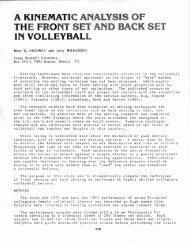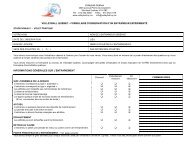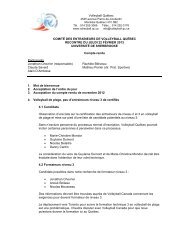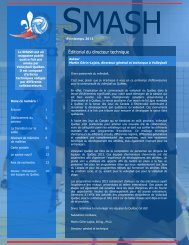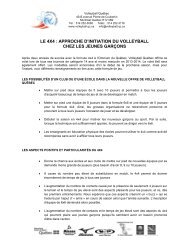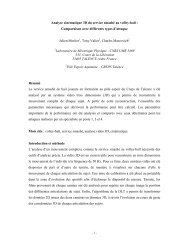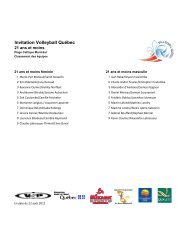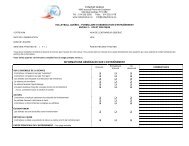An Analysis of the volleyball serve
An Analysis of the volleyball serve
An Analysis of the volleyball serve
Create successful ePaper yourself
Turn your PDF publications into a flip-book with our unique Google optimized e-Paper software.
The Volleyball Jump Serve<br />
One <strong>of</strong> <strong>the</strong> most dramatic skills in modern <strong>volleyball</strong> is <strong>the</strong> spike <strong>serve</strong>, or <strong>the</strong><br />
jump <strong>serve</strong>, which provides an exciting and dynamic skill, that is captivating for<br />
players and spectators alike.<br />
Introduction<br />
The player starts about five meters behind <strong>the</strong> end line <strong>of</strong> <strong>the</strong> court, uses a fast<br />
and explosive run up, a dynamic spike take<strong>of</strong>f and an exciting spike action at<br />
<strong>the</strong> peak <strong>of</strong> <strong>the</strong>ir jump that sends <strong>the</strong> ball across <strong>the</strong> net at speeds <strong>of</strong> over 27<br />
m/s with heavy topspin and at a sharp downward angle. The spike <strong>serve</strong> has<br />
become a dangerous <strong>of</strong>fensive weapon for <strong>the</strong> top <strong>volleyball</strong> teams <strong>of</strong> today,<br />
as a great spike <strong>serve</strong>r can produce a number <strong>of</strong> aces over <strong>the</strong> course <strong>of</strong> a<br />
match. The spike <strong>serve</strong> is somewhat similar to <strong>the</strong> spike at <strong>the</strong> net, except <strong>the</strong><br />
velocities after impact are somewhat lower for <strong>the</strong> <strong>serve</strong> when compared to<br />
<strong>the</strong> spike (Tant, Greene et al. 1993). A study <strong>of</strong> <strong>the</strong> spike vs. <strong>the</strong> <strong>serve</strong> for<br />
collegiate <strong>volleyball</strong> players revealed similar speeds for <strong>the</strong> male athletes but<br />
slower speeds for <strong>the</strong> female <strong>serve</strong> when compared to <strong>the</strong> spike (male jump<br />
<strong>serve</strong> 19.7 m/s, male spike 22.4 m/s, female jump <strong>serve</strong> 13.2 m/s, female spike<br />
17.8 m/s). A study <strong>of</strong> <strong>the</strong> front row spikes <strong>of</strong> elite international <strong>volleyball</strong><br />
spikers reported mean impact ball speeds <strong>of</strong> 27 m/s (Coleman 1993).<br />
It is generally agreed that <strong>the</strong> top jump <strong>serve</strong>rs <strong>of</strong> modern <strong>volleyball</strong> are <strong>the</strong><br />
players who play for Cuba, <strong>the</strong> top men’s team in <strong>the</strong> world over <strong>the</strong> past<br />
decade. These players are generally very tall, <strong>of</strong>ten up to 210 cm and have<br />
very high vertical jumps that allow <strong>the</strong>m to produce a downward angle on <strong>the</strong><br />
ball: a fact exacerbated by <strong>the</strong> heavy topspin usually applied. Their strength<br />
and athleticism also allow <strong>the</strong>m to produce very high hand velocities at impact<br />
that produce high ball velocities that are very difficult for <strong>the</strong> opposition to<br />
return. There are few detailed descriptions <strong>of</strong> <strong>the</strong> techniques <strong>of</strong> <strong>the</strong> spike<br />
<strong>serve</strong> in elite <strong>volleyball</strong> players, so little is known regarding <strong>the</strong> optimal joint<br />
angles and body positions to maximize ball speed. <strong>An</strong> examination <strong>of</strong> <strong>the</strong><br />
<strong>serve</strong>s <strong>of</strong> <strong>the</strong> top players in <strong>the</strong> world may provide some useful information<br />
regarding optimal technique, so that o<strong>the</strong>r skilled players will be able to<br />
emulate this skill and improve <strong>the</strong>ir own ball speed and accuracy. This analysis<br />
was conducted on <strong>the</strong> players <strong>of</strong> <strong>the</strong> 2005 NORCECA Championships, which<br />
included <strong>the</strong> National teams <strong>of</strong> Cuba, United States, Canada, Puerto Rico,<br />
Dominican Republic and Mexico. Over 300 jump <strong>serve</strong>s were filmed during<br />
<strong>the</strong> course <strong>of</strong> <strong>the</strong> championships, held in Winnipeg in September 2005. The<br />
top <strong>serve</strong>rs were analyzed and compared to <strong>the</strong> less skilled <strong>serve</strong>rs<br />
participating in <strong>the</strong> championships, resulting in <strong>the</strong> following analysis.



